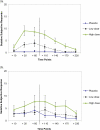Relationships between impulsivity and subjective response in an IV ethanol paradigm
- PMID: 24553574
- PMCID: PMC4101083
- DOI: 10.1007/s00213-014-3458-9
Relationships between impulsivity and subjective response in an IV ethanol paradigm
Abstract
Rationale: Impulsivity and individual differences in subjective response to alcohol are risk factors for alcohol problems and possibly endophenotypes for alcohol dependence. Few prior studies have addressed relationships between the two constructs.
Objectives: To predict subjective responses to ethanol, we tested self-reported impulsiveness, ethanol dose condition (high dose, low dose, or placebo), and time (seven time points) along with interactions among these variables.
Methods: The present study is a secondary analysis of data from a within-subject, placebo-controlled, dose-ranging ethanol administration study using IV infusion with a clamping technique to maintain steady-state breath alcohol concentration. The sample consisted of healthy, non-alcohol dependent social alcohol drinkers between the ages of 21 and 30 (N=105). Participants at varying levels of impulsivity were compared with regard to stimulant and subjective responses to three ethanol dose conditions over time.
Results: Individuals with higher impulsivity reported elavated stimulant and dampened sedative response to alcohol, particularly at the higher dose. Higher impulsivity was associated with a steeper increase in stimulant effects during the first half of clamped ethanol infusion with the higher dose.
Conclusions: These results suggest that impulsive individuals may experience enhanced reinforcing, stimulant effects, and relatively muted aversive sedative effects from alcohol. These subjective responses may relate to enhanced risk of alcohol problems among more impulsive individuals.
Figures


Similar articles
-
Impulsivity Moderates Subjective Responses to Alcohol in Alcohol-Dependent Individuals.Alcohol Alcohol. 2017 Mar 9;52(2):249-255. doi: 10.1093/alcalc/agw096. Alcohol Alcohol. 2017. PMID: 28003245 Free PMC article.
-
Relationships between generalized impulsivity and subjective stimulant and sedative responses following alcohol administration.Psychol Addict Behav. 2019 Nov;33(7):616-625. doi: 10.1037/adb0000512. Epub 2019 Sep 9. Psychol Addict Behav. 2019. PMID: 31497988 Free PMC article. Clinical Trial.
-
Does Self-Reported or Behavioral Impulsivity Predict Subjective Response to Low-Dose Alcohol?Alcohol Alcohol. 2019 Mar 1;54(2):180-187. doi: 10.1093/alcalc/agy092. Alcohol Alcohol. 2019. PMID: 30649160 Free PMC article.
-
Intravenous self-administration of alcohol in rats-problems with translation to humans.Addict Biol. 2017 Nov;22(6):1665-1681. doi: 10.1111/adb.12429. Epub 2016 Aug 2. Addict Biol. 2017. PMID: 27480572 Free PMC article. Review.
-
Alcohol outcomes on anxiety, impulsivity and spatial memory: Possible Omega-3 amelioration effects.Prog Neuropsychopharmacol Biol Psychiatry. 2025 Mar 20;137:111281. doi: 10.1016/j.pnpbp.2025.111281. Epub 2025 Feb 2. Prog Neuropsychopharmacol Biol Psychiatry. 2025. PMID: 39904400 Review.
Cited by
-
Subjective response to alcohol: Associated alcohol use and orbitofrontal gray matter volume in bipolar disorder.J Affect Disord. 2021 Jan 15;279:671-679. doi: 10.1016/j.jad.2020.10.046. Epub 2020 Oct 29. J Affect Disord. 2021. PMID: 33190118 Free PMC article.
-
Genetic influences on alcohol sensitivity: A critical review.Curr Addict Rep. 2024 Feb;11(1):94-104. doi: 10.1007/s40429-023-00530-2. Epub 2023 Dec 28. Curr Addict Rep. 2024. PMID: 40406603 Free PMC article.
-
Interplay of cultural beliefs, psychological disposition, and social milieu during childhood on development of substance use disorder by early adulthood.Exp Clin Psychopharmacol. 2025 Aug;33(4):407-415. doi: 10.1037/pha0000776. Epub 2025 May 5. Exp Clin Psychopharmacol. 2025. PMID: 40323844
-
Subjective response to alcohol in young adults with bipolar disorder and recent alcohol use: a within-subject randomized placebo-controlled alcohol administration study.Psychopharmacology (Berl). 2023 Apr;240(4):739-753. doi: 10.1007/s00213-023-06315-9. Epub 2023 Jan 25. Psychopharmacology (Berl). 2023. PMID: 36695842 Free PMC article. Clinical Trial.
-
Impulsivity Moderates Subjective Responses to Alcohol in Alcohol-Dependent Individuals.Alcohol Alcohol. 2017 Mar 9;52(2):249-255. doi: 10.1093/alcalc/agw096. Alcohol Alcohol. 2017. PMID: 28003245 Free PMC article.
References
-
- Addicott MA, Marsh-Richard DM, Mathias CW, Dougherty DM. The biphasic effects of alcohol: comparisons of subjective and objective measures of stimulation, sedation, and physical activity. Alcohol Clin Exp Res. 2007;31:1883–1890. - PubMed
-
- Bjork JM, Hommer DW, Grant SJ, Danube C. Impulsivity in abstinent alcohol-dependent patients: relation to contol subjects and type 1-/type 2-like traits. Alcohol. 2004;34:133–150. - PubMed
-
- Brunner E, Domhof S, Langer F. Nonparametric Analysis of Longitudinal Data in Factorial Experiments. John Wiley & Sons; New York, NY: 2002.
Publication types
MeSH terms
Substances
Grants and funding
LinkOut - more resources
Full Text Sources
Other Literature Sources
Medical

